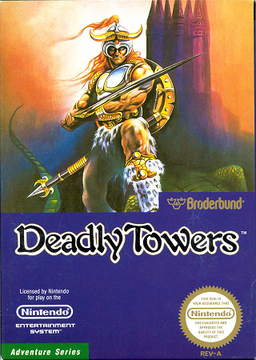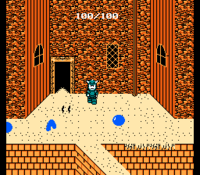- Deadly Towers
-
Deadly Towers 
Front cover of Deadly Towers package.Developer(s) Lenar Publisher(s) - NA Irem
Platform(s) NES Release date(s) Genre(s) Action role-playing game Mode(s) Single-player Rating(s) Media/distribution 1-megabit cartridge Deadly Towers is an action role-playing video game developed by Lenar and exclusively-licensed by Irem as a software title for the Nintendo Entertainment System (NES). It was released in Japan on December 15, 1986, and in North America in September of the following year. One of the earliest published console role-playing games for the NES in North America,[1] Deadly Towers was a best-selling title in 1987.[2]
In Japan, Deadly Towers was titled Mashō (魔鐘), literally meaning "Evil Bell". It is a pun of the word mashō (魔性), meaning "devilishness", and in keeping with this theme, the Japanese cartridge contained a red LED at the top which illuminated when turned on.[3] Irem intended the game's English-language title to be Hell's Bells, but Nintendo of America refused to issue the game a Nintendo Seal of Quality unless Brøderbund changed the name.[4]
Contents
Plot
On the moonlit eve of his coronation ceremony, pensive Prince Myer sits at the lakeside to ponder the future of the kingdom. Suddenly, a shadowy kami called Khan rises from the lake and coalesces into the form of a man. Although he doesn't identify himself, the figure greets Prince Myer by name, and informs him that Rubas, the "Devil of Darkness", is preparing to overtake Willner Kingdom by using seven magic bells capable of summoning an army of monsters.
To ensure peace, Khan says, Prince Myer must travel to the northern mountain to burn the Seven Bells in the sacred flame, burn down the seven bell towers in Rubas' magic palace, and, ultimately, defeat Rubas himself.
Gameplay
The game takes place from a isometric side-scrolling view, where the player can walk in any direction. The player is equipped with a sword which is thrown to attack enemies. A new sword cannot be thrown until the first sword exits the screen or hits an enemy, unless the player has found an item called the double shot. This mechanic- coupled with the fact that most of the game's enemies take several hits to kill- is a significant grievance that players have with the game. Ironically, the game's instruction manual says "you have no confidence in this sword."
The player can find shops which cycle their inventory between various pieces of equipment that allow the player to sustain more damage and other such effects. The game's currency is called "ludder" and the player obtains ludder by picking it up from downed enemies. The bulk of the game takes place in labyrinthine dungeons where the player must navigate a long series of rooms with several branching paths to reach and defeat the seven main bosses, before the final battle against Rubas. One of the biggest complaints against the game is that the game's mazes are exceedingly difficult to navigate and it is easy to get lost without finding a map or etcetera walkthrough.
Hidden throughout the game are invisible portals to a secret area called the Parallel Zone, where the player can find equipment that is superior to the equipment found in stores.
Reception
When released in 1987, the game became a best-selling title in North America.[2] As one of the first Japanese action role-playing games to be published in North America (alongside Rygar), Computer Gaming World described it as a new kind of role-playing game that differed from both the console action-adventure games (such as Castlevania, Trojan, and Wizards & Warriors) and American computer role-playing games (such as Wizardry, Ultima, and Might & Magic) that American gamers were previously more familiar with at the time. Deadly Towers was particularly notable for its permanent power-up mechanic, which at the time blurred the line between the power-ups used in action-adventures and the experience points used in RPGs.[1]
Despite the game's commercial success in its time,[2] however, the game has received a more mixed reception from retrospective critiques. A writer for the Video Game Bible, 1985-2002 reports that he found the game's varied levels entertaining,[5] whereas Sean Reiley, writing in 2001 for his comedy website Seanbaby.com, dismissed it as the worst Nintendo game of all time.[4]
References
- ^ a b Adams, Roe R. (November 1990), "Westward Ho! (Toward Japan, That Is): An Overview of the Evolution of CRPGs on Dedicated Game Machines", Computer Gaming World (76): pp. 83-84, "While America has been concentrating on yet another Wizardry, Ultima, or Might & Magic, each bigger and more complex than the one before it, the Japanese have slowly carved out a completely new niche in the realm of CRPG. The first CRPG entries were Rygar and Deadly Towers on the NES. These differed considerably from the "action adventure" games that had drawn quite a following on the machines beforehand. Action adventures were basically arcade games done in a fantasy setting such as Castlevania, Trojan, and Wizards & Warriors. The new CRPGs had some of the trappings of regular CRPGs. The character could get stronger over time and gain extras which were not merely a result of a short-term "Power-Up." There were specific items that could be acquired which boosted fighting or defense on a permanent basis. Primitive stores were introduced with the concept that a player could buy something to aid him on his journey."
- ^ a b c Arnie Katz, Bill Kunkel, Joyce Worley (August 1988), "Video Gaming World", Computer Gaming World (50): p. 44, "Designed by the same crew that produced the best-selling Deadly Towers."
- ^ Ciprian, Jason (4 September 2009). "Deadly Towers Famicom Flashback: Let There Be Light!". MTV Networks. http://multiplayerblog.mtv.com/2009/09/04/deadly-towers-famicom-flashback-let-there-be-light/. Retrieved 7 March 2011.
- ^ a b Reiley, Sean (2001). "The Worst Nintendo Game #1 - Deadly Towers". http://www.seanbaby.com/nes/w20-01.htm. Retrieved 7 March 2011.
- ^ Andy (2002). "Nintendo Entertainment System". In Slaven, Andy. Video Game Bible, 1985-2002. 1. Victoria: Trafford Publishing. p. 95. ISBN 9781553697312. OCLC 50185883.
Sources
- Deadly Towers Instruction Manual. Brøderbund, 1986.
External links
Categories:- 1986 video games
- Action-adventure games
- Lenar games
- Nintendo Entertainment System games
Wikimedia Foundation. 2010.

